Low maintenance garden borders are great options for anyone who wants to grow green areas without spending too much time or effort maintaining their garden.
With a little planning and creative thinking, you can still enjoy a yard filled with colorful flowers throughout the year without spending hours each week tending to your plants.
With the right gardening techniques, you can reduce the amount of work involved while enjoying the benefits of a more relaxing garden environment.
By choosing native, hardy plants that require less maintenance and no-dig gardening, you may improve the health and structure of your soil.
HOW To keep my GARDEN Border remains easy to maintain all year round?
Select plants that require minimal care and attention to ensure your garden borders remain low maintenance.
Methods of creating a low-maintenance lawn, suggests Sheila Jack, include:
- Selecting Resilient, Drought Tolerant Plants
- Analyzing your site conditions to see if they would benefit from being moved around
- Keep weeds at bay – you’ll end up with what you start with; therefore, aim to eliminate as much of the existing weed material as possible.
- Plant at a moderate rate
- Adding bulbs layer by layer
- Mulching helps maintain soil health by retaining water and prevents weed seeds from germinating. It is a great way to control unwanted vegetation.
- Watering for the first time
- Leave Seed Heads Over Fall & Winter
WHAT ARE THE BEST WAYS TO MAKE My GARDEN border Astonishing?
Create a low-maintenance landscape design that looks excellent year-round by adding a mix of evergreen shrubs, hardy perennial plants, and colorful annual flowers.
While using raised beds or edging materials can help to keep your planting nice and controlled, mulching and no-dig gardening techniques will help to keep weeds at bay.
So, We all know that maintenance and feedings help to create a sustainable garden, and attracting pollinators and other beneficial insects improves biodiversity for a wildlife-friendly garden, including a backyard. Are there any different ways to keep it healthy? Specifically, the border,
These are ten supplemental Low Maintenance Garden Border Ideas to complete a video available on the page, and we hope your learning experience too.
20. Keep the “RIGHT PLANT on the RIGHT PLACE.”
For low maintenance borders, consider the following before planting: assess the conditions, light levels, soil, and moisture; choose plants suited to the location.
Look for plants that can withstand droughts, such as the ones you would pick if designing a dry garden, which can deal with some neglect during hot times if your border is sunny. These include Lavender’ Hidcote’, Rosemary, and Echinacea purpurea, Echinops bannaticus for seasonal impact.’ Says gardening expert Alice Ferguson.
There are many plants suited to a sunny location. They include some of the Mediterranean favorites, such as lavender and rosemary.
A border with little sun exposure requires some form of shading. Consider planting a variety of evergreen and deciduous ferns, such as Dryopteris wallichiana, Polypodium vulgare, and Blechnum spicant. A combination of Mahonia eurybracteata subsp. ganpinensis’ Soft Caress’ and Sarcococca hookeriana would also work. The latter grows well in full sun.
Before planting, do your homework. ‘Find out how big the plant will get over time, and give it enough room,’ says gardening expert Sue Townsend. “Position essential shrubs carefully as they are more difficult to move as they grow larger.”
19. Select Tough PLANTS to keep your maintenance time minimal later
A great way to ensure your garden borders stay looking good year after year is to plant plants that are tough and consistent and complement each other beautifully.
“Incorporating resilient plants that, in their natural habitat, could live as part of a community and grow at a moderate rate,” says Sheila Jack.
‘Ornamental grasses, for example, Sesleria autumnalis and Helictotrichon sempervirens with Achillea’ Terracotta,’ Salvia nemorosa’ Caradonna,’ Echinops ritro ‘Veitch’s Blue’ and Kniphofia that combine color and form with a long season of flowering and little maintenance.’
‘Hardy geraniums, such as Gerardia rosanonensis and Paeonia emodi, are great for knitting among plants, adding impactful colors during the summer, and filling in the gaps. Alchemilla Mollis has a similar habit, yet with bright lime green color,’ says Alice Ferguson.
18. Select low-maintenance landscaping.
Select plants that look after themselves and don’t require much maintenance.
“Avoid plants that require frequent trimming, staking, or extra feeding, such as rose bushes, but low maintenance doesn’t have to mean a border of only static shrubs,” says Sue Townsend.
‘Many types of grass, such as Pennisetum hameln, Chinese fountain grass, panicum shenandoah, switchgrass, ferns, and perennials, including white gaura, and hylotelephium “herbstfreude group,” just require a cutback once a year. Alternatively, go through and straighten them up. For structure, flowers, and smell, combine these with a few evergreen shrubs that don’t require trimming, like Hebe rakaiensis, Mexican orange blossom, Daphne X transatlantica Eternal Fragrance, or other flowering evergreens,’ Sue adds.
Be careful not to plant too many large trees near each other because they are much easier to move once planted. Perennial plants and grasses are also relatively easy to relocate.
If you combine with other organic gardening techniques, such as companion planting, you can cultivate a garden where the crops grow happily together and mostly look after themselves.
17. INCLUDE AN EVERGREEN BACKBOUND such as Shrubs
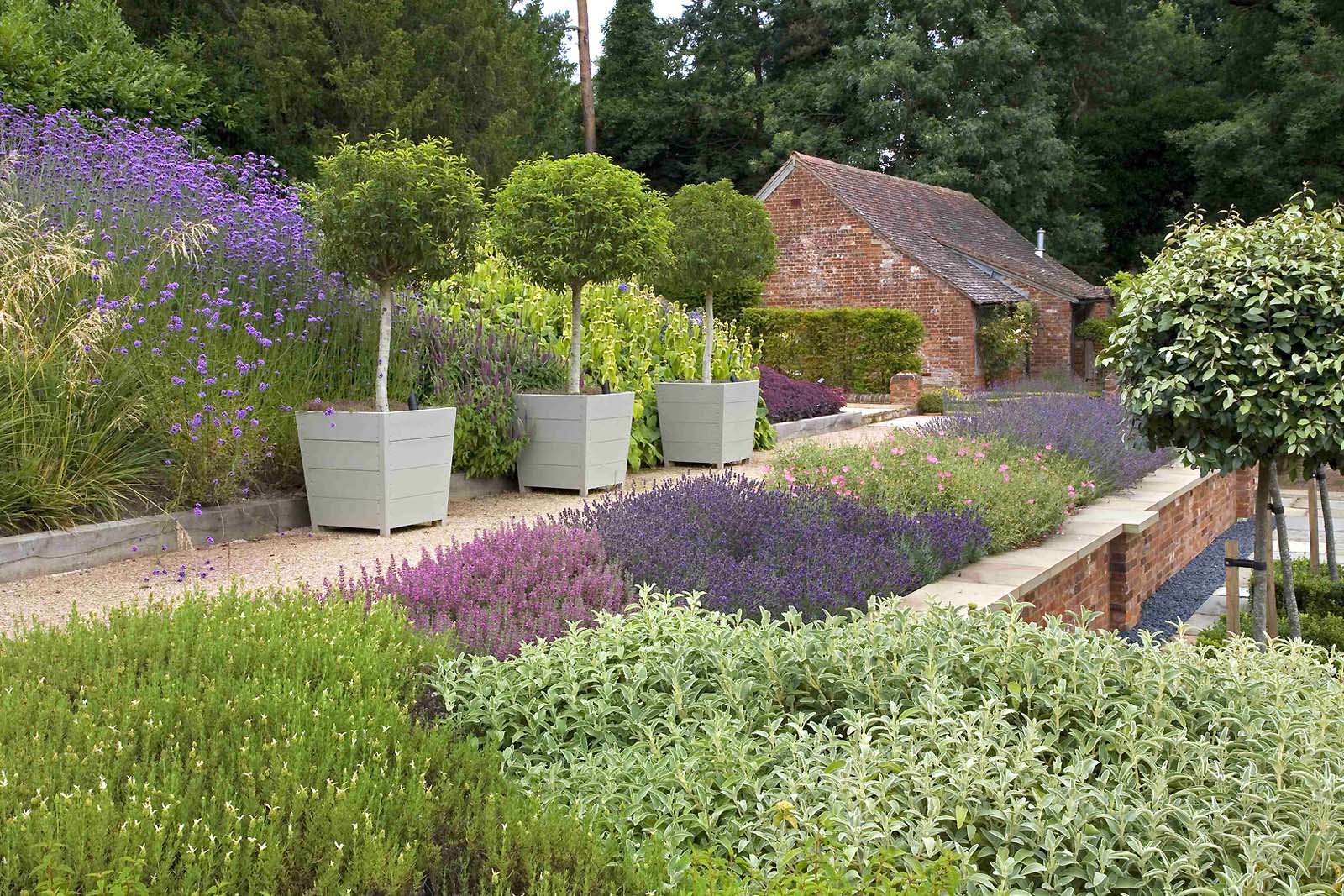
Create a foundation of evergreen shrubs with a repeating pattern of hardy and hard-working perennials with long growing seasons. According to Alice Ferguson, repeat patterns are great for impact, balance, and ease of care.
Learn how to divide perennials and plants to extend the life of your bouquets while saving money on your floral arrangements.
“Bring your evergreen building up to the border’s front. Your perennial plants will be concealed under the evergreen shrubs as they begin to die back. This provides a neat appearance and a great backdrop for any seasonal flowers you wish to plant.”
“A repeating plant matrix provides a more coherent and pleasing design than a border bursting with a large variety of plants which can appear messy to the eye,” says Alice.
16. Use edging to create neat borders.
Lawn edging and border edging ideas are low-maintenance garden border ideas to keep borders looking tidy and stop the creep across paths or lawns. If the border is proud and edging exposed, consider a material worth being on display, such as slate, Corten steel – with its rustic patina – or mild steel for a more modern look. Otherwise, timber edging to contain the planting within its border has a neat finish and works well.
‘Steel, brick, or stone edgings, if adjoining a lawn, all work well and can also be used as a mowing strip.
‘Raised garden beds can be created using timber, Corten steel, bricks, or stones, but it is important to think about how much water and drainage you require.’
One thing, ‘Your garden border doesn’t Have To Mean Evergreens Or Sterile,’ Says Gardener Sheila Jack
15. Liming easy-to-care garden beds
Permaculture gardens rely heavily on mulch to retain moisture in the soil, reduce weed growth, and keep nutrients contained within the soil.
“Use peat-free compost, homemade compost, or opt for gravel, decorative pebbles, or even building waste materials, such as crushed concrete or brick,” says Sheila Jack.
Mulches come in many forms, including pine needles, grass clippings, straw, leaves, peat moss, sawdust, and even shredded paper. For other mulching materials, Alice suggests composted wood chips or bark, “which also provides a neat appearance to the border,” she says. Organic options to consider include well-rotted horse manure and leaf mulch.
14. To add interest, consider adding Spring or Summer Bulbs
Add layers of annual flowers, which will naturally spread throughout the garden over several years.
‘Snowdrops and narcissus will grow happily in partial shade. With more sun, tulips and alliums add a beautiful burst of color. Allium sphaerocephalon ‘Purple Sensation’ also provides beautiful seedheads through winter.
13. Utilize A HANDS-OFF APPROACH
Make a single, straightforward cutback in late winter instead of fall to keep things interesting all year. You can enjoy the winter’s dried grass and flower seedbeds in this manner.
Leave plants to grow where they are so that they decompose and enrich the soil. This helps the plant’s natural cycle of growth and decay. Also, give seeds a chance to spread themselves around so that nature does its job.
12. A NO-DIG garden METHOD is recommended
No-dig gardens require little time and effort as a gardener, so it makes sense to include this type of garden planter idea at the top of your list of low-maintenance garden borders.
No-dig gardening entails adding a layer of well-rotted garden compost in the spring and fall, controlling weed growth, and maintaining healthy soil.
No-Dig gardening requires minimal work and allows you to grow plants without disturbing the roots of surrounding plants. You can also avoid spending hours weeding and digging over borders.
11. PLANT IN GRAVEL
One of the low-maintenance garden borders that have inspired Sheila Jack is planting into a thick layer of gravel mulch.
‘Plants are added into a layer of ‘fine’ sand, ranging in depth from 10 to 20 centimeters, as a gardening concept.’ She explains.
‘Gravel does not contain any weeds. This means that, unlike soil, gravel contains no weed seeds. The rapid drainage allows water to drain away rapidly, so weed seeds blown onto the planting aren’t likely to grow. Rainfall also helps permeate through the gravel, allowing water to soak in.’ She adds, ‘Even in the summer heat when moist soils are hard and impermeable; gravel plantings can still absorb rainfall.’ Source
Still relevant to our current discussion, we present to you
10 Low-maintenance garden borders Video
Under the video, you can find the written version of the video. If you prefer to jump to action immediately, you can check the reference section first to minimize misinformation.
A gardener’s dream borders provide structure and definition to a landscape while also adding visual interest. They can even be a barrier between sidewalks and roads, creating a buffer zone between pedestrians and traffic.
Garden edging can do more than just separate your flowerbed from the lawn. It turns out that it can enhance your yard landscaping. If you are looking for exquisite edging for your plants, stroll through this list of ten garden border ideas to complete your curb appeal. As always, Simphome presents you with the list.
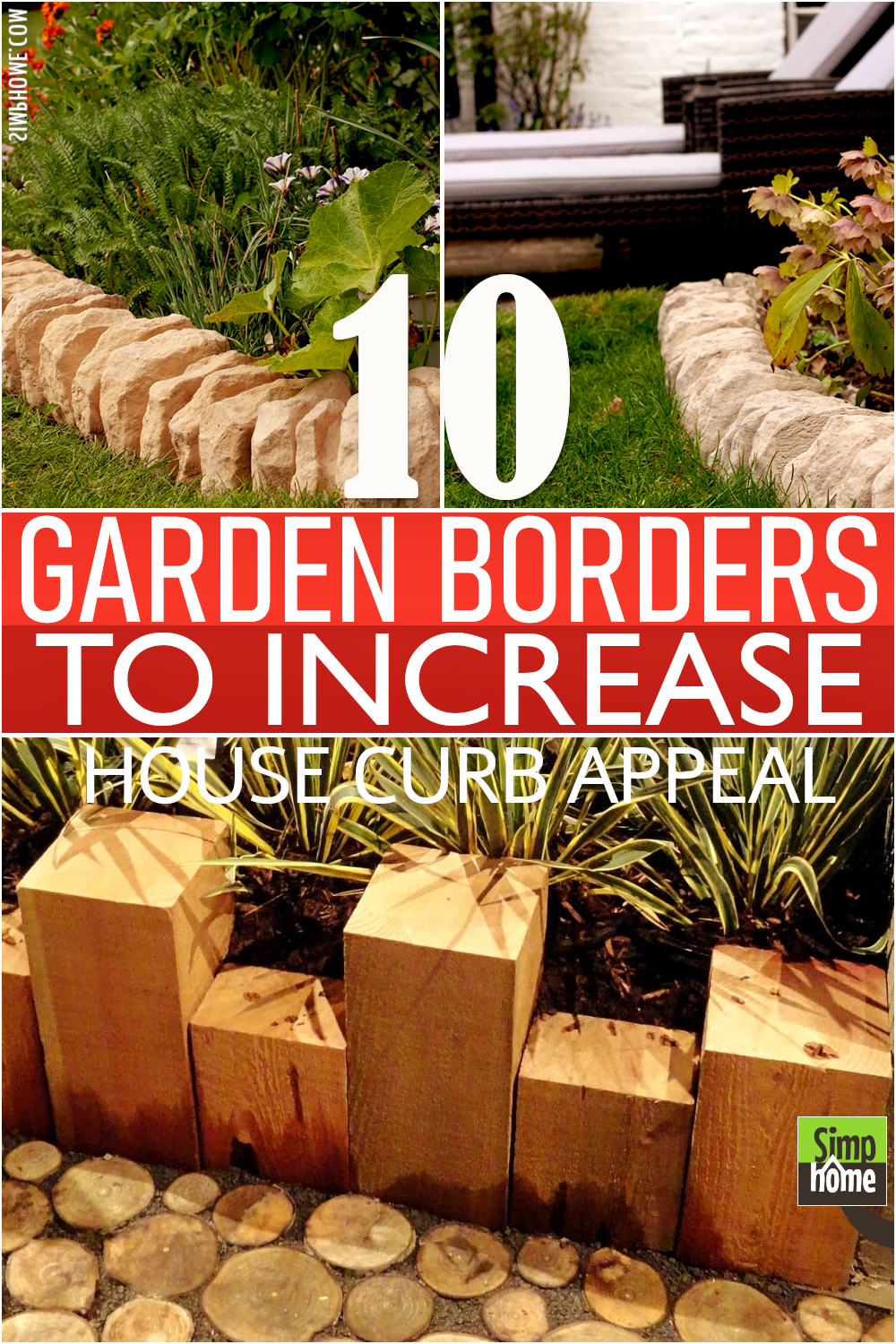
10. Brick edgings give instant cottage garden appeal
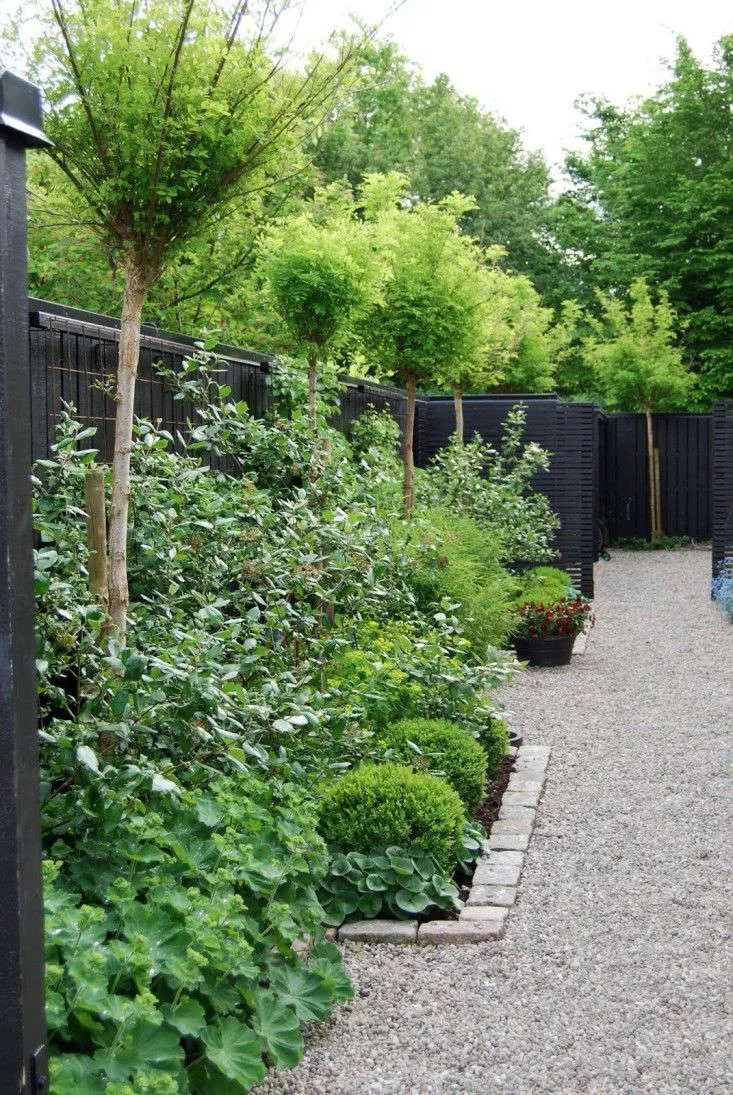 Bricks, also known as pavers, are a great way to add architectural interest to your garden. The red brick variety can significantly complement any landscape design and style.
Bricks, also known as pavers, are a great way to add architectural interest to your garden. The red brick variety can significantly complement any landscape design and style.
Moreover, bricks are a great choice for your cottage garden because they provide a classic, traditional appeal, and attractive appearance. They also work well with modern and rustic styles and are very easy to maintain and repair.
A border made of brick walls can be created by digging trenches around the outside edges of your flower beds and filling them with concrete. This type of border is also called a “perimeter” or “outdoor wall.”
Next, lay down newspapers or landscape fabric over the entire surface of the ground, then sprinkle sand evenly over the top. This will ensure the soil stays moist while you work. Now, you can begin laying your bricks.
Lay the bricks any way you wish, but remember that the walls must be at least 3 inches thick. The thickness of each brick determines how much weight the wall will hold. So, you can either lay the bricks lengthwise for the inner edges or widthwise for the outer edges. If you do this, you can stack more bricks between those already laid.
9. Add decorative metal garden edging around the perimeter of your yard
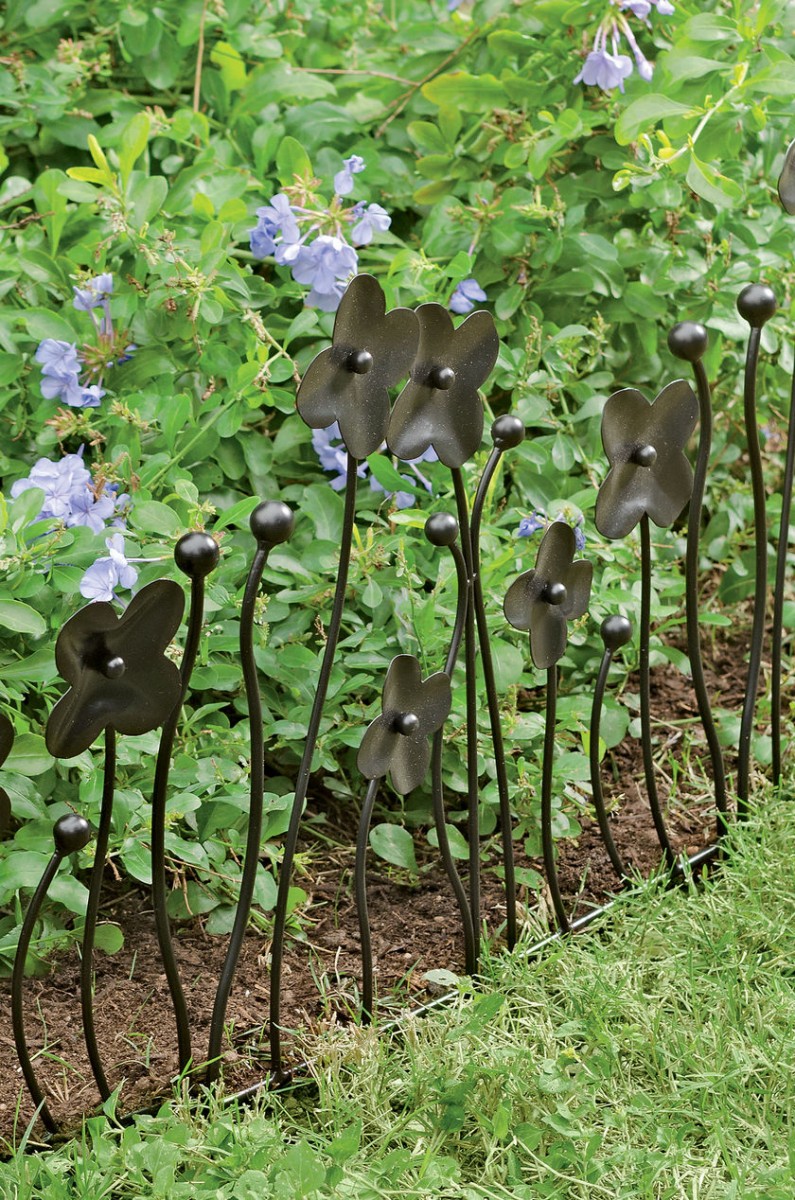 Metal decorative garden edging comes in a variety of styles and colors. They are durable and come in many shapes and sizes. You can get them underground, above ground, along fences, and even around trees. Metal garden edging helps stop weeds from growing too quickly because it prevents soil from becoming saturated. If you plant flowers, shrubs, or trees, you can use this type of edging to keep the plants in place.
Metal decorative garden edging comes in a variety of styles and colors. They are durable and come in many shapes and sizes. You can get them underground, above ground, along fences, and even around trees. Metal garden edging helps stop weeds from growing too quickly because it prevents soil from becoming saturated. If you plant flowers, shrubs, or trees, you can use this type of edging to keep the plants in place.
Decorative metal garden edging also has some downsides. It tends to rust and stain the ground and the surrounding structures. Some types of metal are also expensive, which isn’t a great option if you want to create a budget-friendly landscape design.
8. Decorate your yard using modern landscaping techniques
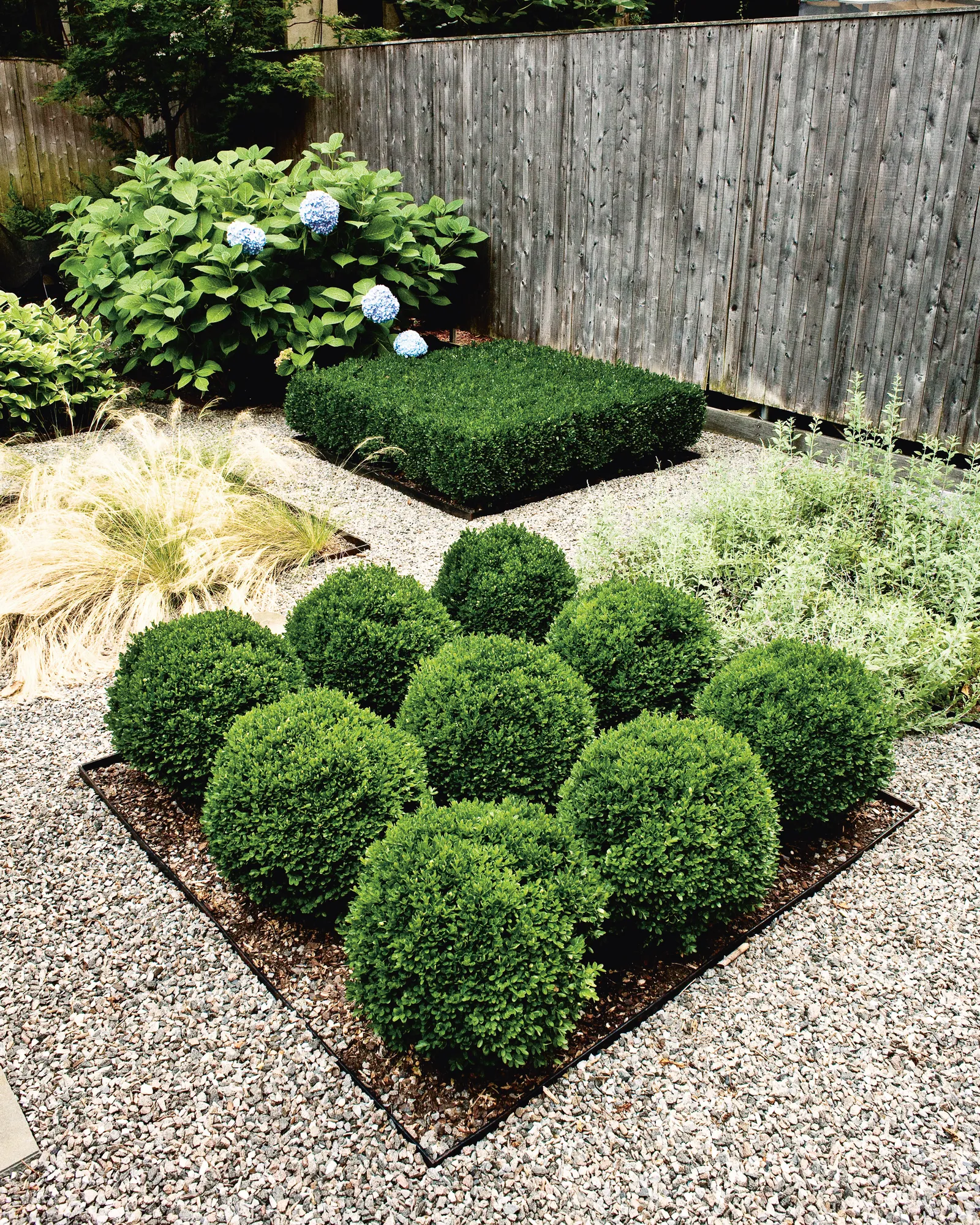 A modern landscape design is something that many homeowners are starting to incorporate into their yards. If you are interested in this type of design, then consider combining various elements to create a beautiful border around your property.
A modern landscape design is something that many homeowners are starting to incorporate into their yards. If you are interested in this type of design, then consider combining various elements to create a beautiful border around your property.
This garden features metal edging around its borders to give it a sharp and crisp appearance. This design is both simple and sophisticated, which is the hallmark of contemporary gardens.
Additionally, metal edging can prevent garden materials like gravel and mulch from migrating to other areas. It is also your safest bet because it won’t break down when cold temperatures occur.
Metal Garden Edges: Steel vs. Aluminum? The answer depends on what type of metal you prefer. Steel is probably the way to go if you’re looking for something sturdy because it won’t rust and is also very durable. Aluminum is another option because it’s lightweight and robust.
Steel is durable enough to last through the ages. The only downside is that it rusts over time. Steel is what you’re after if you’re looking for something that will last.
Even though it isn’t as strong as steel, heavy gauge aluminum can still make a nice-looking garden edging. You can make flower beds from wood planks that define the bed well while providing a lovely rustic feel. You can also find stones that offer a smooth transition between modern and rustic styles and add more texture to the space.
7. Turn On The Lights
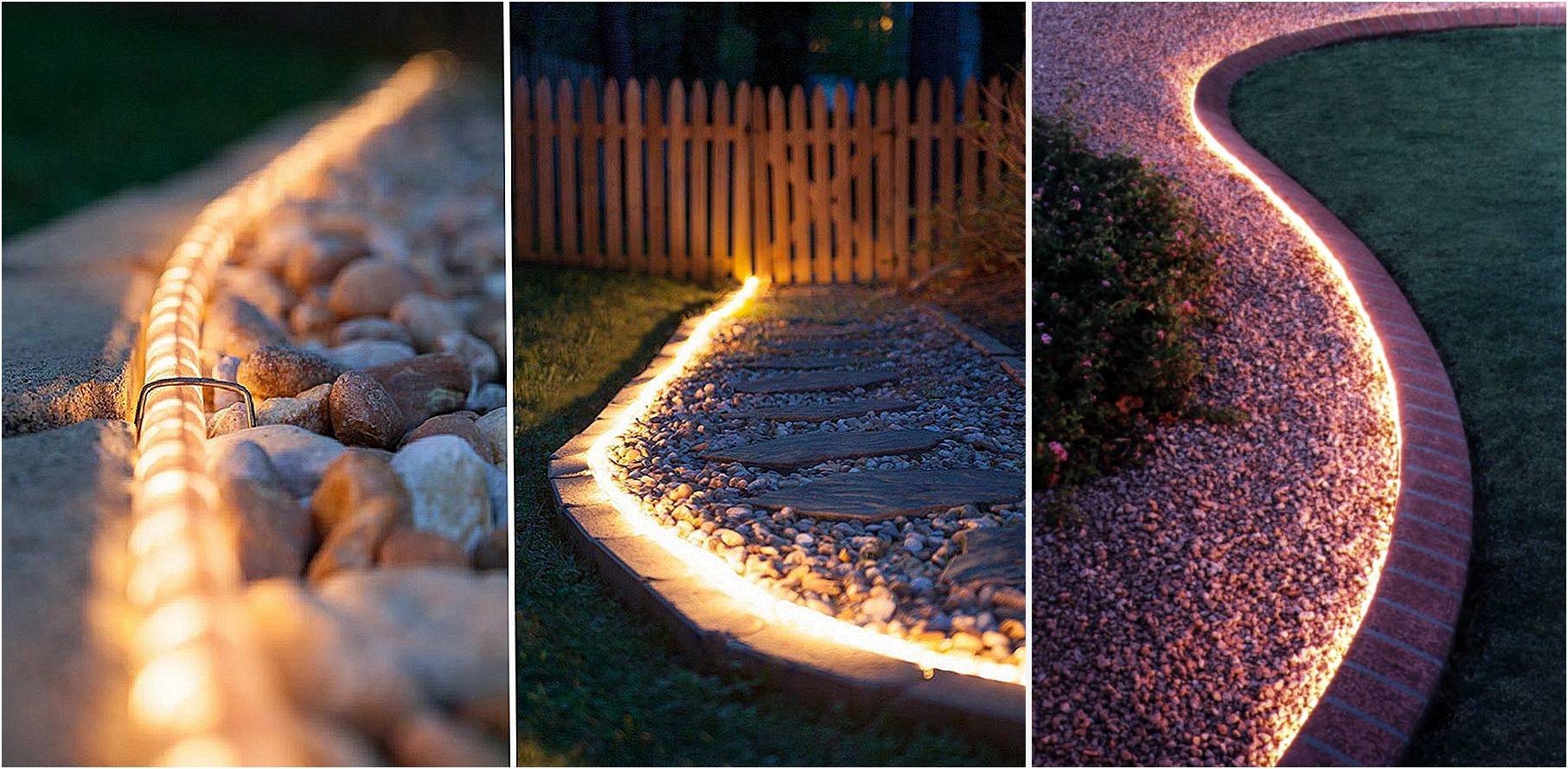
This front lawn looks great at night, thanks to the LED lighting installed along the inside edges of the brick. The light bulbs highlight the curved design of the borders, giving this space a stylish appearance.
Introducing contrasts helps enhance the visual impact of your landscape. If you have questions about curb appeal ideas that draw attention to front homes, follow the link to get more insights and perspective.
6. Contrast your landscape
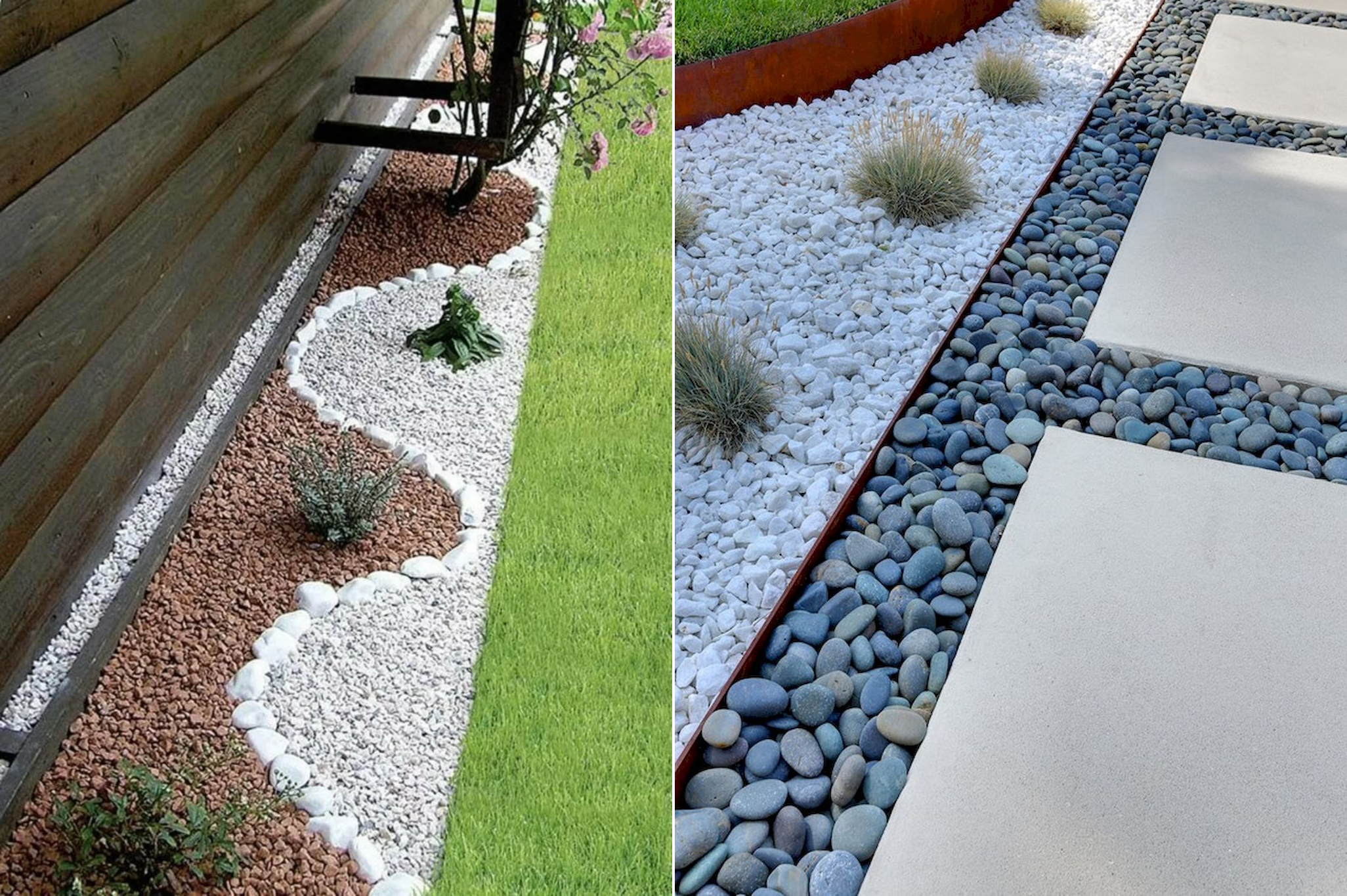 Contrasting your landscape design elements with different colored stones creates visual interest and helps to define space.
Contrasting your landscape design elements with different colored stones creates visual interest and helps to define space.
Flower beds are great ways to introduce color and texture to any yard.
The first step is creating a border around the entire bed. This creates a visual barrier between the grass and flowers while providing privacy. Next, plant colorful annuals along the edge of the bed. These plants grow quickly and provide a burst of color throughout spring and summer. Finally, fill the center of the bed with perennials, shrubs, and ground covers. You can combine colors and textures within each group. For example, mix tall perennials with shorter ones, or include deciduous and evergreen species. Don’t forget to mulch your flower bed after planting. Mulching helps retain moisture and prevents weeds from growing.
The homeowner used metal to create a clear-cut boundary that separated the lawn from the crushed rock. Metal also helped prevent the grass from growing over the yard’s edge.
The second yard introduces the contrast of dark and light stones filling the space around the concrete stepping stones. You can still find metal edging here to separate the pebbles and maintain the contrasting look.
Return to our countdown; let’s continue our discussion with
5. Use stones to create a natural look
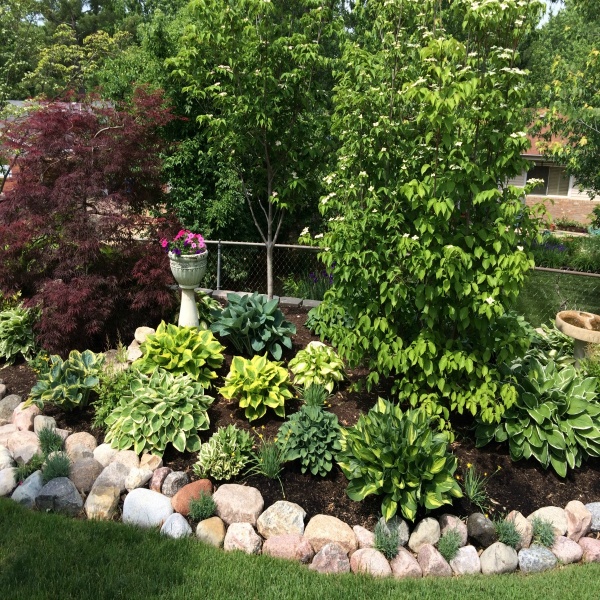 Stone is a popular choice when creating garden edging, especially if you want to carve out a natural look. Stone makes this vibe instantly.
Stone is a popular choice when creating garden edging, especially if you want to carve out a natural look. Stone makes this vibe instantly.
Stone is beautiful and affordable, so it makes sense to invest in it. However, it does require some maintenance. Make sure to put down a layer of mulch around the stones before planting anything else. This will ensure that weeds won’t grow between the stones and that the soil stays moist. Once you plant something, water it regularly until the plants get established. If you decide to remove the stones after a few years, you can just dig them out without damaging the plants.
Consider installing the stone edging since this material can weigh quite a bit. So, let a landscape contractor do it for you.
4. Consider adding bamboo edging around the edges of your bedding
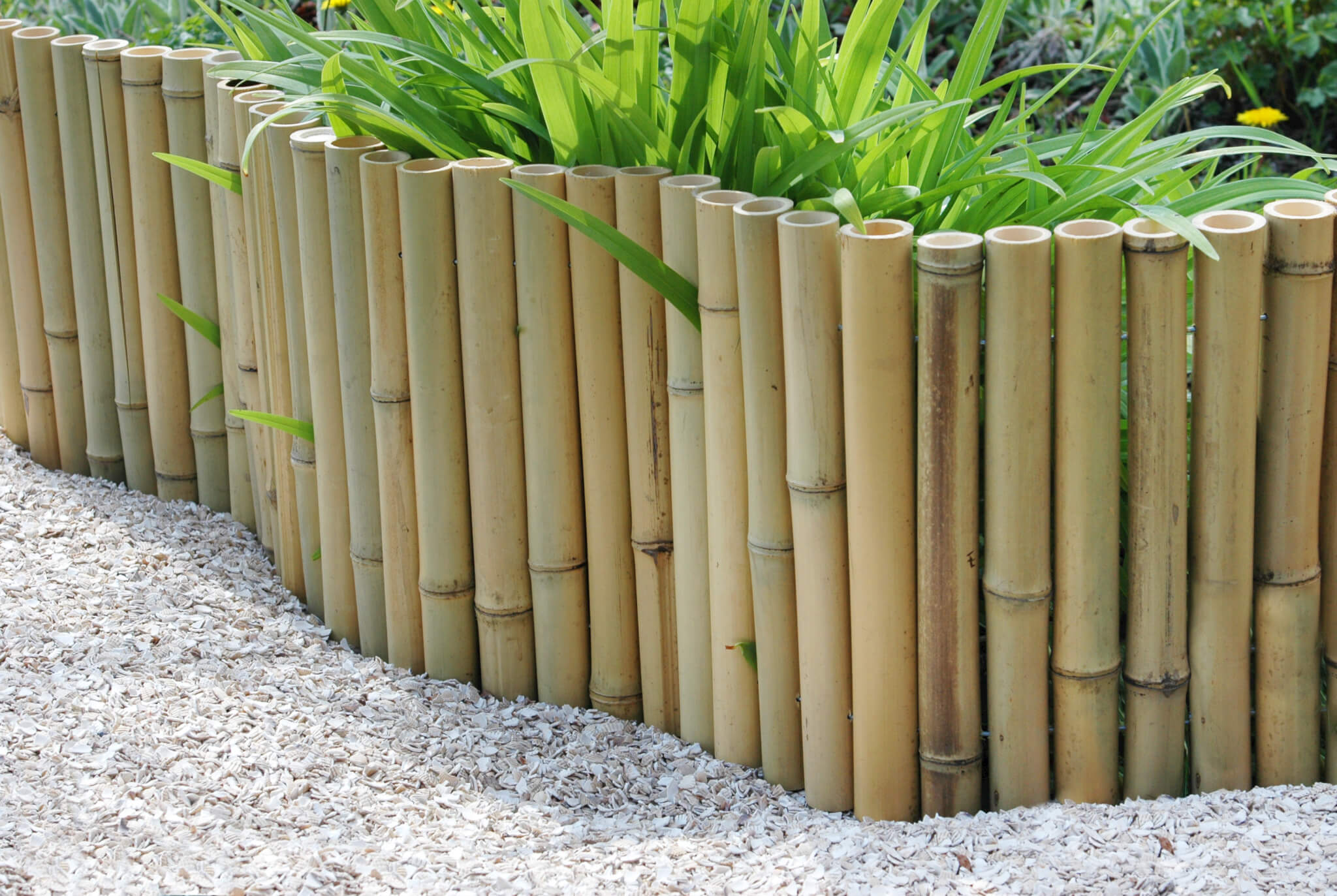 Bamboo is a great addition to any landscape because of its natural beauty and versatility. Consider planting bamboo if you want to incorporate Asian style into your garden.
Bamboo is a great addition to any landscape because of its natural beauty and versatility. Consider planting bamboo if you want to incorporate Asian style into your garden.
Bamboo is often associated with Asia. This material is used to construct Zen gardens, so you can incorporate its natural beauty into your backyard.
Create the Asian vibe you want by simply planting bamboo around the flower bed or adding a water feature. You can also stagger the plants to give the appearance of a natural border.
3. Staggered edging with four by four posts
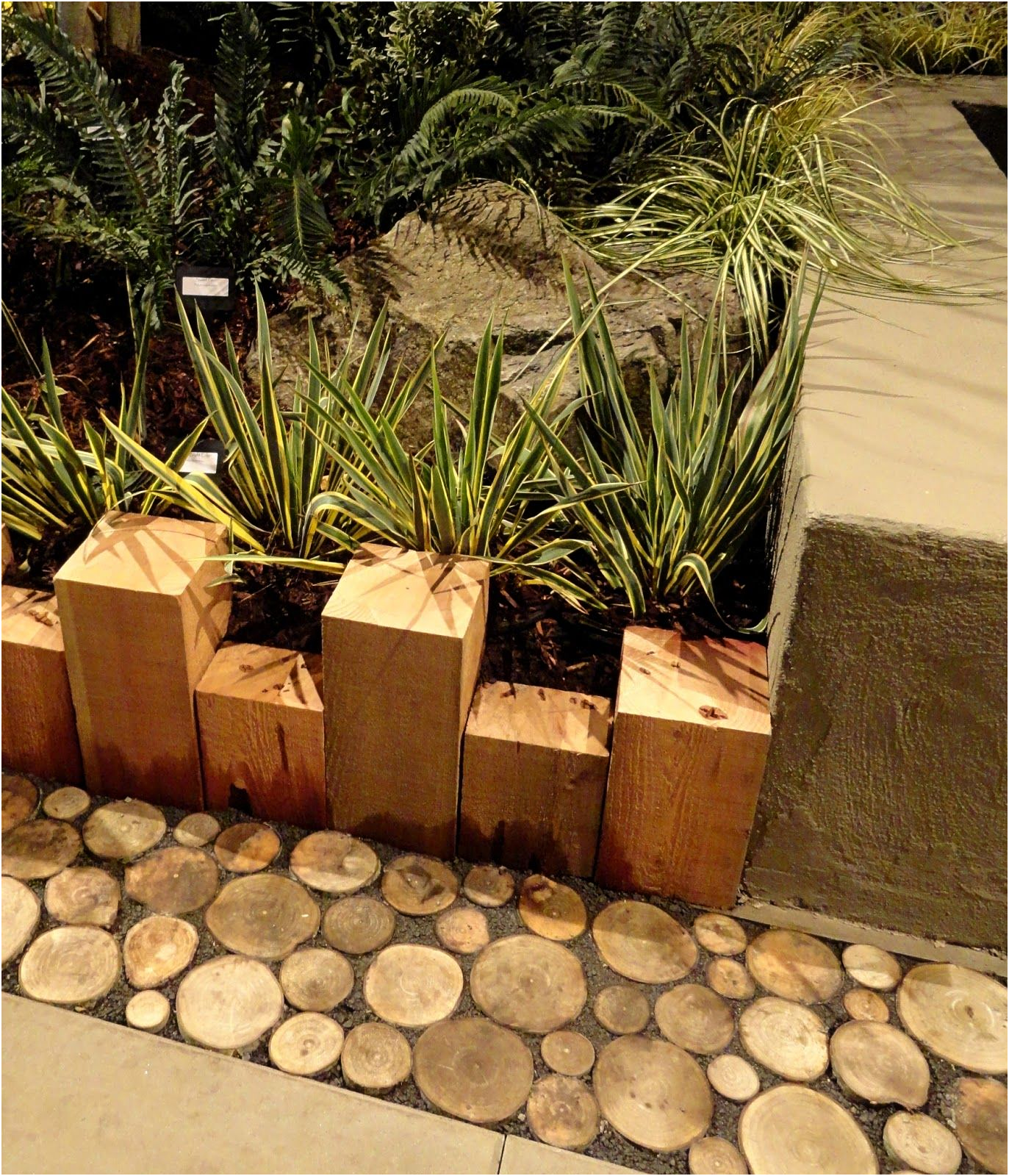 With this garden edging, you can copy this look using 4×4 wooden posts. Installing the posts in a staggered arrangement creates a beautiful design and makes your garden more attractive.
With this garden edging, you can copy this look using 4×4 wooden posts. Installing the posts in a staggered arrangement creates a beautiful design and makes your garden more attractive.
To create the outer edge, you can also lay some wood pieces along the posts. This will improve the curb appeal of your home.
2. Terracotta pots garden edging ideas
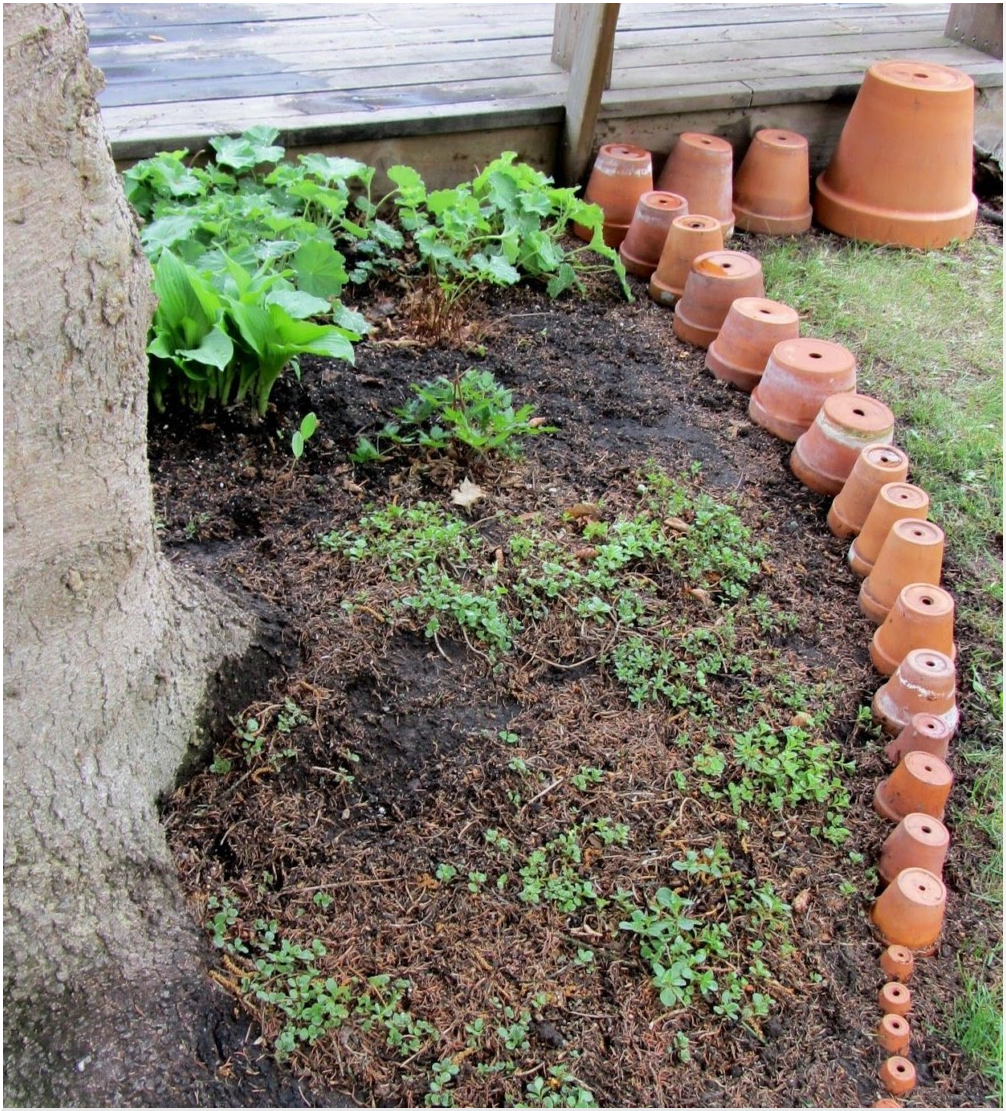 Try these ideas if you have been searching for something different than just plain old concrete blocks!
Try these ideas if you have been searching for something different than just plain old concrete blocks!
Garden edging isn’t limited to any particular material. In fact, you could even create one made of terracotta pots.
If you have just a small space available, you might consider using terracotta planters instead of flowerpots. They don’t require much room and allow you to grow flowers year-round. You can even plant them outdoors during the winter months.
Lastly, Number 1. A Rustic edging idea with Tree Logs
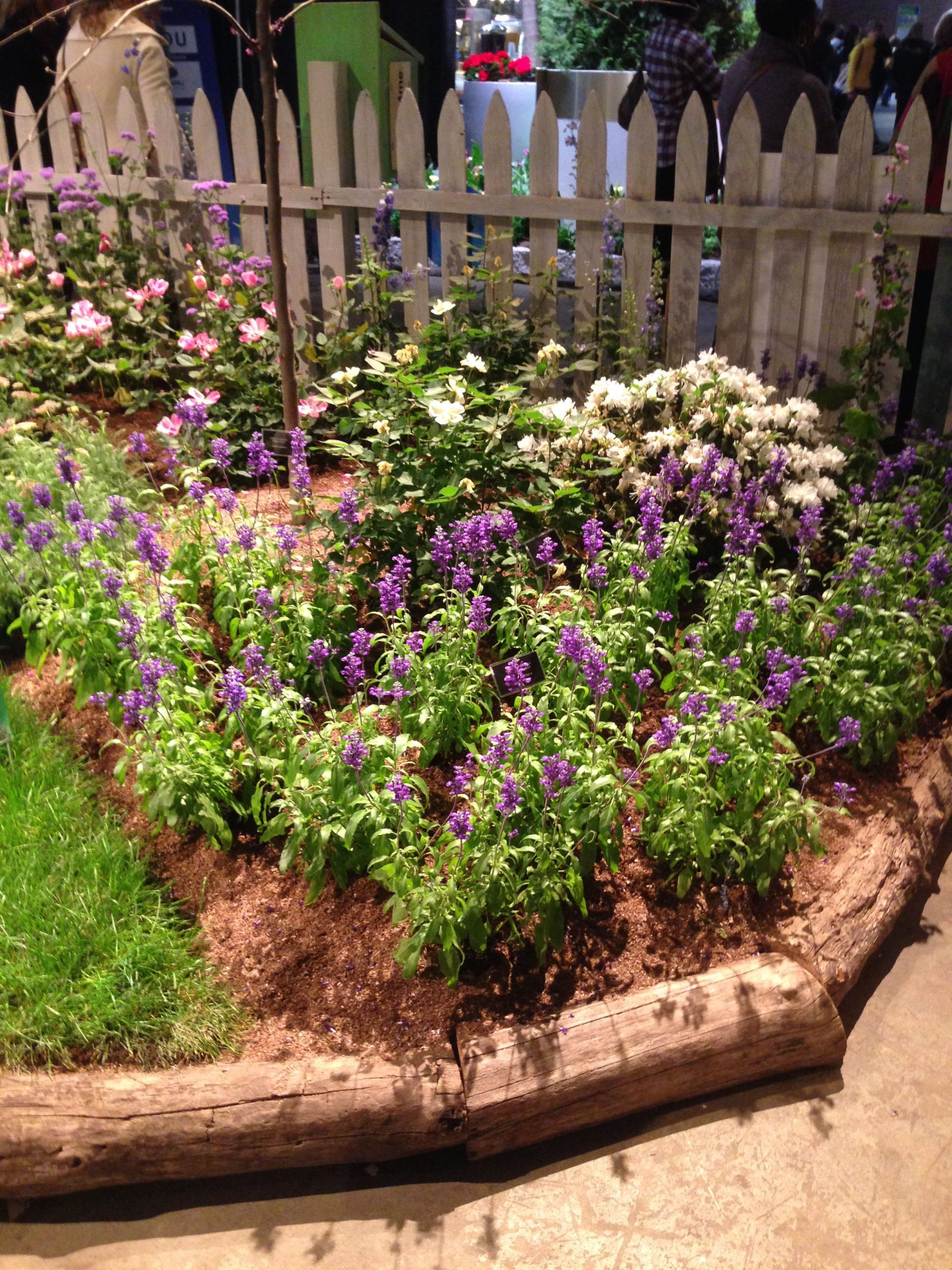 If you love rustic styles, this garden edging idea is an ideal choice for you. To achieve this look, you must plant trees around your garden bed. Then, stand back and admire the results.
If you love rustic styles, this garden edging idea is an ideal choice for you. To achieve this look, you must plant trees around your garden bed. Then, stand back and admire the results.
They can serve as a great addition to any backyard landscape. They can also provide extra seating for family gatherings.
Whether you are looking to spruce up your front yard with some creative landscaping or just want to improve the appearance of your home, these ten garden border ideas will give you plenty of inspiration. This way, you can provide a stunning vista that will impress onlookers.
References:
10. Thekitchengarten.com, Gardenista.com
9. Homedesigninspired.com
8. Gardenista.com
7. Plantcaretoday.com
6. Homesthetics.net, Plantcaretoday.com
5. Gharpedia.com
4. Farmfoodfamily.com
3. Morningchores.com
2. Homedesigninspired.com
1. Homedesigninspired.com